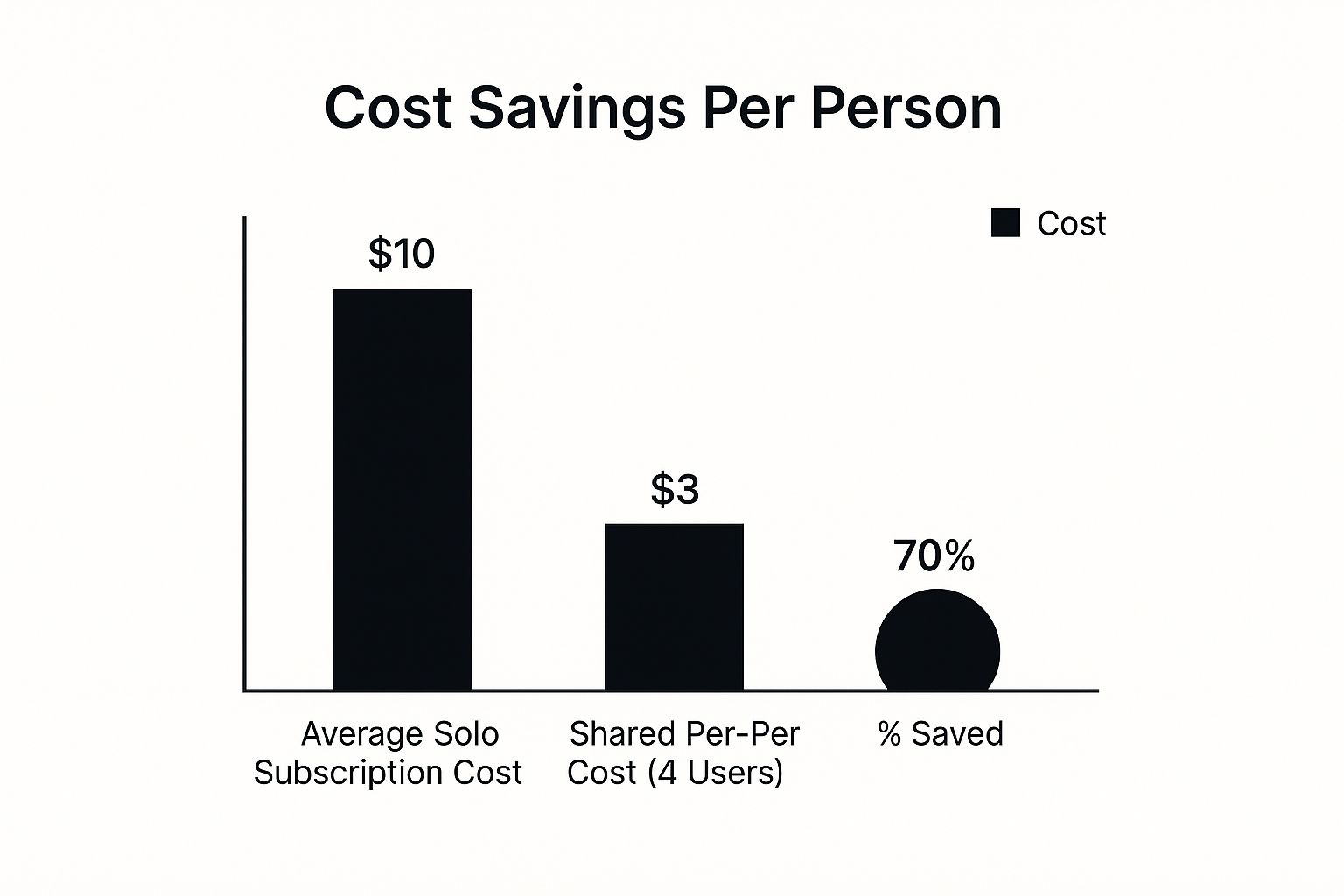
Smart Guide to Sharing Streaming Services Without the Drama
Share
Why Everyone's Talking About Streaming Service Sharing

The world of on-demand entertainment has grown immensely. What began with a single subscription has turned into a sprawling network of platforms you just can't miss. Juggling Netflix's latest blockbuster, a Disney+ series, and the dramas on Max can feel like a part-time job with a surprisingly steep monthly cost. This feeling, known as subscription fatigue, is a big reason why sharing streaming services has become such a hot topic. It's not just a clever move for college kids anymore; it's a smart financial strategy for consumers everywhere.
Think of it like a digital potluck dinner. Instead of each person bringing a huge dish they could never finish alone, everyone contributes one main course for the group to share. Suddenly, you have a feast of options without the individual expense and waste. This team-based approach to entertainment is a direct answer to the rising costs and scattered nature of the streaming market. People are pooling their resources instead of picking one or two services and missing out.
The Rise of a New Economic Model
This change isn't just a small trend; it's a massive global movement. As of 2025, the worldwide streaming market boasts over 1.1 billion subscribers. This huge growth shows a clear preference for on-demand content, pushing the market's value toward a projected $184 billion by 2027. As more platforms appear and prices go up, the logic behind sharing streaming services becomes crystal clear. You can find more details about these industry trends by exploring these streaming services statistics.
This new reality has created strong reasons for sharing. The main drivers behind this trend are straightforward and powerful:
- Financial Necessity: The biggest motivator is simple economics. An average household can easily spend more than $50 a month on different subscriptions. Sharing can cut these costs by 50-75% or more, freeing up a good chunk of the monthly budget.
- Expanded Content Access: No single service has everything. Sharing lets a group tap into a much larger library of movies, shows, and exclusives than any one person could afford alone. One person's Netflix subscription perfectly complements another's access to Hulu and Disney+.
- Simplified Management: While it might sound complicated, modern ways of sharing actually make things easier. Instead of juggling multiple logins and payments, a group can combine its entertainment spending, making it simpler to track who has access to what.
This shift from a niche trick to a common practice shows how consumers are adapting to the media environment. By sharing streaming services, viewers are taking back control, making sure they get the most value and variety for their money without being buried by individual costs.
What Sharing Streaming Services Actually Looks Like

When you hear about sharing streaming services, your mind might jump to a frantic group chat with someone pleading for a password. The reality, however, is often much more organized. Today's sharing models are less about casual password swaps and more about creating small, well-managed entertainment groups. These setups can range from officially approved plans to informal but disciplined circles of friends.
Successful sharing doesn't just happen; it requires clear communication and a sense of mutual benefit. It turns what could be a headache into a smooth, cost-effective way for everyone to watch what they love.
Imagine a few friends deciding to pool their entertainment resources. One friend takes on the Netflix Premium plan, another pays for the Disney Bundle, and a third covers a Max subscription. They each create separate profiles on every service and share the login details within their trusted group. This approach, known as subscription stacking, grants everyone access to a huge library of content for the price of a single subscription.
Common Sharing Structures
People organize their sharing arrangements in a few common ways, each with its own pros and cons depending on the group's trust level and goals. Understanding these structures is the first step toward building a system that works for you and your friends.
To help you visualize the options, here is a breakdown of the most popular sharing methods.
| Sharing Type | User Limit | Cost Structure | Official Support | Typical Use Case |
|---|---|---|---|---|
| Official Family Plan | Varies (e.g., Netflix: 5 profiles) | Single monthly fee for multiple users | Yes, directly offered by the service | A family or household sharing one account with separate profiles. |
| Informal Friend Group | Depends on simultaneous stream limits | Members pay for different services and share | No, relies on user agreement and trust | Friends stacking subscriptions to access a wider content library. |
| Rotational Subscription | Depends on simultaneous stream limits | One subscription paid at a time, rotated monthly/quarterly | No, managed entirely by the group | A group wanting to binge-watch specific shows without long-term commitments. |
| Account Sharing Platform | Varies by service | Platform fee + proportional share of subscription cost | Facilitated, but not officially endorsed by services | Individuals looking to join a sharing group with strangers safely. |
As the table shows, there's more than one way to share. Official Family Plans are the simplest and most secure, as they are designed by the streaming services themselves. Methods like subscription stacking and rotational subscriptions, on the other hand, offer greater flexibility and cost savings but require a high degree of trust and organization among members.
Here’s a closer look at the most common arrangements for sharing streaming services:
- Official Family Plans: These are the multi-user plans offered directly by services like Netflix or Disney+. They come with built-in features like individual profiles and support for multiple simultaneous streams, making them the most straightforward sharing option.
- Informal Friend Groups: This is the "subscription stacking" model we talked about earlier. Its success depends entirely on trust, especially when it comes to managing payments and account access.
- Rotational Subscriptions: Some groups adopt a "one-at-a-time" strategy. They might subscribe to Max for a couple of months to watch its exclusive shows, then cancel and switch to a service like Paramount+ for its content. This ensures they see all the major releases without paying for every service simultaneously.
These structures prove that sharing streaming services can be a smart, strategic decision. While some companies are becoming stricter about password sharing, others like Crunchyroll remain more flexible, making them ideal for group arrangements. By selecting the right services and establishing a clear system, you can create a stable and affordable entertainment setup that benefits everyone involved.
The Real Numbers Behind Streaming Sharing Savings

While having endless entertainment at our fingertips is fantastic, let's be honest: the main reason people explore sharing streaming services is to save money. The cost of individual subscriptions adds up fast, turning what seems like a small monthly fee into a significant line item in your budget. When you actually crunch the numbers, the financial upside of sharing is too big to ignore. Smart viewers are regularly slashing their entertainment costs by 60-80% without giving up their favorite shows.
This isn't some magic trick; it's a direct result of how streaming companies price their plans. Many services offer premium tiers with perks like 4K streaming and multiple simultaneous screens. These features are often overkill for one person but are perfectly suited for a group to share.
A Practical Budget Breakdown
Let's walk through a common scenario. Imagine you want access to Netflix Premium, the Disney Bundle (which includes Hulu and Disney+), and Max. If you subscribed to each of these on your own, you could easily be looking at a bill over $50 per month, or $600 per year. For most people, that's a hefty price for entertainment.
However, the moment you form a sharing group of four, the entire financial picture changes. The table below shows just how drastically the costs drop when you split them.
| Service Tier | Cost Alone (Monthly) | Cost Shared (4 People) | Monthly Savings | Annual Savings |
|---|---|---|---|---|
| Netflix Premium | $22.99 | $5.75 | $17.24 | $206.88 |
| Disney Bundle Premium | $19.99 | $5.00 | $14.99 | $179.88 |
| Max Ultimate Ad-Free | $19.99 | $5.00 | $14.99 | $179.88 |
| Total Cost | $62.97 | $15.75 | $47.22 | $566.64 |
In this example, each person in the group pays just $15.75 a month for three top-tier services. That's a total savings of nearly 75%! This incredible value is precisely why sharing streaming services has become a popular financial strategy. This is all happening in a huge global market, which was projected to reach USD 108.73 billion in 2025. You can learn more about the booming demand for on-demand content to see the sheer scale of the industry.
Beyond the monthly fees, sharing also helps you avoid other hidden costs. For example, instead of several people paying extra for ad-free upgrades, one premium plan can cover everyone. Platforms like AccountShare streamline the process of managing these shared payments, ensuring everyone pays their portion without any awkward reminders. If you want even more tips, take a look at our guide on how to save money on streaming services.
How Each Platform Handles Sharing (The Inside Scoop)
Not every streaming platform sees sharing the same way. Each service has its own rules, shaped by its business goals, position in the market, and the technology it uses. Knowing these differences is key if you're thinking about sharing streaming services, as it helps you pick a platform that works for your group and keeps you from running into account trouble.
Think of it like this: some services throw a casual, open-house party where friends of friends are welcome. Others host a strict, invitation-only event. To have a good time, you need to know what kind of party you're walking into before you show up.
The Big Players and Their Policies
The official rules for sharing streaming services are always changing, but we can see clear patterns among the industry giants. Services like Netflix and Disney+ have tightened their policies, officially limiting sharing to a single household but offering paid "extra member" slots. This is their way of turning password borrowers into paying customers.
On the other hand, some platforms are more relaxed. Services like Crunchyroll and Paramount+ are generally considered more sharing-friendly, allowing multiple profiles and simultaneous streams without strict household rules. This makes them popular choices for informal groups of friends who want flexibility. These differences matter in a competitive market like the U.S., where as of 2025, Amazon Prime Video holds a 22% market share, slightly ahead of Netflix at 21%. However, Netflix's dominance in other regions, with a 24% share in Canada and 27% in the U.K., shapes its stricter global approach. You can get more details on the current streaming market dynamics to see how these trends play out.
Comparing Key Platform Features
To help you make a smart choice, it’s useful to see how the major services compare directly. The table below breaks down the sharing policies, features, and costs of popular platforms, giving you a clear picture of what to expect from each.
Major Streaming Platforms Sharing Policies Comparison
Detailed breakdown of sharing features, restrictions, and costs across popular streaming services
| Platform | Family Plan Price | Max Users | Simultaneous Streams | Geographic Restrictions | Sharing Detection |
|---|---|---|---|---|---|
| Netflix | $15.49-$22.99/mo | 5 profiles | 2-4 | Strict (Household Only) | IP & Device Monitoring |
| Disney+ | $13.99/mo (No ads) | 7 profiles | 4 | Strict (Household Only) | IP & Device Monitoring |
| Amazon Prime Video | Included with Prime | 6 profiles | 3 | Household (Amazon Household) | Household Account Link |
| Max | $15.99-$19.99/mo | 5 profiles | 2-4 | Household Only | IP & Device Monitoring |
| Paramount+ | $11.99/mo (with SHOWTIME) | 6 profiles | 3 | Flexible | Less Strict |
| Crunchyroll | $7.99-$15.99/mo | 1 user, 6 profiles | 1-6 | Flexible | Less Strict |
This table shows that while most major players are cracking down, some still offer the flexibility that makes group sharing attractive. Services like Paramount+ and Crunchyroll stand out as better options for non-household groups due to their more lenient policies.

As the infographic highlights, the financial argument for sharing is powerful. Splitting a typical subscription with three other people can slash your personal cost by as much as 70%. This huge saving is the primary motivation behind group sharing. Platforms like AccountShare streamline this process, making it easy to manage cost-splitting and ensure everyone contributes their fair share without any awkward conversations.
Keeping Your Shared Accounts Safe and Drama-Free
Once you've gathered your streaming crew and tallied up the savings, the next job is to make sure the whole arrangement stays secure and friendly. While sharing streaming services is built on trust, a few smart safety habits are essential for protecting everyone's data and avoiding future arguments. After all, a shared password can sometimes open the door to more than just a movie library; it might expose payment details and other personal info.
Think of it like being a good roommate. You wouldn't leave the front door unlocked or peek at their private mail, right? The same ideas of respect and security apply in the digital world. The aim is to create a system where everyone feels their privacy is safe while getting uninterrupted access to their favorite shows.
Essential Security Practices
Good security doesn't have to be complicated, but it does require a bit of thought. Simple routines can save you from big headaches later. For example, instead of just texting a password where anyone could see it, using a secure password manager is a much smarter way to share login details. These tools encrypt sensitive information, ensuring only your approved group members can get to it.
Here are a few fundamental practices every sharing group should put in place:
- Use Unique Passwords: Never recycle a password from your email or bank account for a shared streaming service. Always create a strong, unique password specifically for the account you're sharing.
- Leverage Individual Profiles: This is the single most important step for keeping the peace. Every person in the group needs their own profile. This keeps viewing histories, watchlists, and recommendations separate, so one person's binge-watching of reality TV doesn't mess up another's movie suggestions. For more tips on this, check out our guide on how to maximize Netflix family sharing.
- Establish Clear Payment Rules: Figure out a payment system right from the beginning. Whether one person covers the bill and gets paid back through an app like Venmo, or you use a platform like AccountShare to handle payments automatically, being clear prevents awkward money conversations.
- Protect the Primary Account Holder: The person whose credit card is linked to the account carries the most risk. They should be the only one with the power to change billing information or the subscription plan itself.
By establishing these ground rules from day one, you build a solid foundation for your sharing group. This proactive approach lets everyone relax and focus on what truly matters: enjoying a massive entertainment library for less, without any of the drama.
Playing by the Rules (Without Killing the Fun)
Trying to understand the terms and conditions of a streaming service can feel like deciphering a legal document meant to be confusing. But when it comes to sharing streaming services, getting a handle on these rules is key to keeping your group account in good standing and avoiding any drama. The main point isn't usually about sharing itself, but where you're sharing.
Most big names, like Netflix and Disney+, have updated their policies to officially limit sharing to a single household. This isn't a moral stance against sharing—it's a business move to turn password borrowers into their own paying subscribers. Think of it like a family pass to a theme park; it's designed for people living together, not the whole block. Bending this rule probably won't land you in court, but it might get your account flagged or restricted, which is a major headache for everyone in your group.
The Ethical Side of Sharing
Beyond the official terms, the best sharing groups are built on fairness and mutual respect. This goes deeper than just splitting the bill. It's about recognizing that you're all chipping in for content made possible by thousands of artists, writers, and production crew members. When everyone contributes fairly, it helps ensure these creators get paid, which in turn supports the making of more shows you love.
Here are a few ground rules that successful sharing groups live by:
- Prompt Payments: Everyone agrees to pay their portion on time, without fail. This saves the account owner the awkward task of chasing people down for money.
- Respecting Limits: Members honor the agreed-upon number of simultaneous screens. If the plan allows for four streams, no one tries to fire up a fifth and boot someone else off.
- Clear Communication: If a member needs to leave the group, they provide enough notice to find a replacement or adjust the subscription plan accordingly.
Finding a Sustainable Balance
The ultimate goal is to enjoy the huge cost savings and broad content library that comes with sharing streaming services without stirring up trouble. This means operating within reasonable limits. While sharing with friends in different cities is common, it exists in a bit of a gray area.
Platforms like AccountShare help formalize these arrangements by managing payments, adding a layer of accountability for everyone. By playing fair and respecting both the service's rules and your fellow group members, you can set up a long-lasting system where everyone comes out ahead.
Your Complete Sharing Success Blueprint
Turning your streaming budget from a source of anxiety into a smart, cost-effective system is well within your reach. This action plan breaks down everything into a practical roadmap, guiding you from a quick assessment to long-term success with sharing streaming services. The heart of any successful group is a clear and mutually accepted set of rules.
Think about it like planning a group vacation. You wouldn't just show up at the airport without tickets or a hotel booked. Instead, you'd all agree on a destination, set a budget, and decide on an itinerary. Applying that same level of planning to your streaming setup is the secret to preventing arguments and making sure everyone gets what they paid for.
Step 1: Evaluate and Identify
Before doing anything else, it’s time to take inventory of your current streaming subscriptions. A simple table is a great way to see everything clearly.
| Current Service | Monthly Cost | Who Uses It? | Keep or Replace? |
|---|---|---|---|
| Netflix Premium | $22.99 | Me, Partner | Keep |
| Max | $15.99 | Me | Replace (Share) |
| Disney+ Basic | $9.99 | Partner | Upgrade & Share |
This quick audit shows exactly where your money is going and shines a spotlight on the subscriptions that are perfect for sharing. Once you have your list, think about potential sharing partners—reliable friends, family, or roommates who have similar taste in shows and are trustworthy.
Step 2: Establish Clear Agreements
Once you have your group, communication becomes your most important asset. The next step is to hash out a simple, clear agreement that covers all the important points. This is your best defense against future misunderstandings. Your agreement should cover:
- Payment Plan: Who is paying for each service, and how will everyone else pay them back?
- Profile Etiquette: A commitment from each person to stick to their own profile to keep recommendations and watch histories separate.
- Stream Limits: A friendly reminder to respect the number of screens that can be used at one time on the plan.
- Exit Strategy: What’s the plan if someone decides to leave the group? Agreeing on a notice period is a good idea.
For a more detailed look at handling group dynamics, especially with family, our guide on Netflix family sharing provides even more helpful advice.
Ready to put this blueprint into practice without the headaches? AccountShare handles every step, from managing payments to organizing group access, so you can enjoy all the perks of sharing without any of the hassle.
